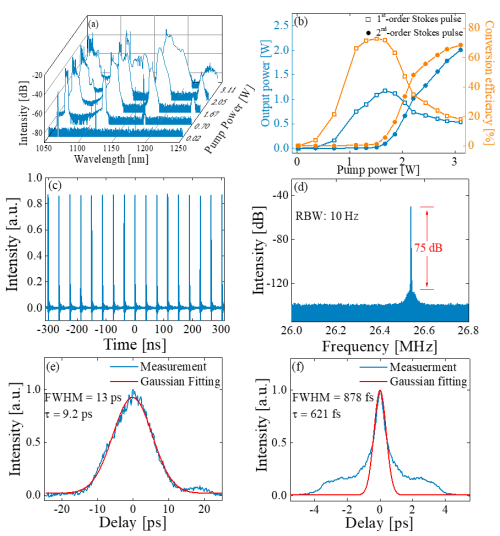Recently, a research team from Shanghai Institute of Optics and Fine Mechanics (SIOM) of the Chinese Academy of Sciences (CAS) reported a new approach to generate high pulse energy femtosecond pulses at 1178 nm by cascaded nonlinear optical gain modulation (NOGM) with a 1064 nm picosecond pump laser. The results were published in Optics Express on March 2, 2022.
Researchers proposed a new method to obtain highly coherent femtosecond Raman pulses at 1120 nm in previous work. However, in order to fill up all the spectrum gap left by the emission bands of rare earth doped fibers, cascaded Raman progress is necessary. The cascaded NOGM creates the possibility to obtain high performance Raman pulses at versatile wavelength with simple structure.
In the demonstration, both 1121 nm and 1178 nm single frequency laser are injected into a Raman fiber amplifier, which is pumped by a 1064 nm picosecond pulse laser. The two-stage NOGM setup generates 1178 nm pulses with a pulse energy of 76 nJ and a pulse duration of 621 fs (after compression) under an optical conversion efficiency of 65%.
Numerical simulations based on generalized nonlinear Schrodinger equation (GNLSE) are carried out to reveal both temporal and spectral evolution mechanism of the pump and Raman pulses in the experiments. The simulations also indicate that by designing the NOGM amplifier with proper Raman fiber length, pump pulse energy and pump pulse duration to reduce the walk-off effect, high pulse energy and wavelength-agile femtosecond pulses can be obtained with higher conversion efficiency and shorter pulse duration.
The novel method combines the advantages of simple and stable compact, high pulse coherence and high optical conversion efficiency.

Fig. 1. (a) The configuration of the cascaded NOGM setup. Amp: amplifier, WDM: wavelength division multiplexer; CPS: cladding power stripper. (Image by SIOM)

Fig. 2. (a) Spectrum and (b) 1st-order and 2nd-order output power and conversion efficiency as a function of the pump power; (c) pulse train; (d) radio frequency (RF) spectrum; (e) autocorrelation trace before and (f) after compression. (Image by SIOM)
Article website:
https://opg.optica.org/oe/fulltext.cfm?uri=oe-30-6-8889
Contact:
WU Xiufeng
General Administrative Office
Shanghai Institute of Optics and Fine Mechanics, CAS
Email: xfwu@siom.ac.cn
Web: http://english.siom.cas.cn/